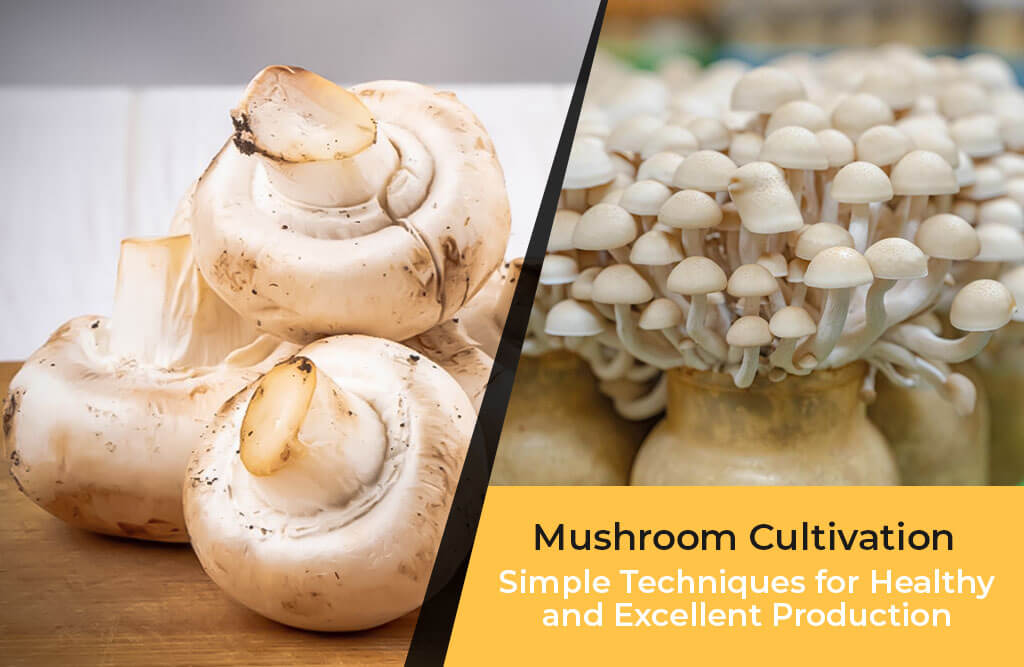
Embark on the rich history of mushroom cultivation, tracing its roots to the 18th century and witnessing a significant surge in India from 1940. While the progress has been gradual in some states, Odisha, Andhra Pradesh, Tamil Nadu, and Kerala stand out. With a demand for high temperatures, mushroom cultivation proves to be a year-round, excellent option. Rich in raw protein, fiber, and a diverse blend of essential amino acids, mushrooms emerge as a wholesome dietary source. Abundant raw materials for cultivation are available throughout the country, ensuring a steady supply. With its high protein content, optimal production, and integration into various culinary options, mushrooms are making a mark in the expansive market. Explore the journey of these nutritious fungi, contributing to a healthier lifestyle.
Making Mushroom Compost: The process of making mushroom compost involves carefully blending and moistening materials. Placing the ingredients in a rectangular heap with tight edges and a loose center ensures proper temperature and essential airflow. The bulk materials are usually added through a compost turner, and water is sprinkled over them if it's horse manure or synthetic fertilizer, as these materials move through the turner. Nitrogen doses and gypsum are spread atop the bulk materials, and then thoroughly mixed by the turner. Once the heap becomes moist and well-formed, the development of microorganism’s kicks off, leading to the aerobic microbial composting that naturally enriches the compost with essential elements. This method ensures the safest and most effective way to create complete and potent compost.
The application of fertilizer in mushroom cultivation is crucial for eliminating any pests, nematodes, insects, molds, or other harmful organisms. Additionally, conditioning the fertilizer and removing the ammonia generated during various stages are vital processes. Excessive ammonia concentration, especially in mushroom spawn development, can act as a hindrance, making its removal essential. Generally, the human nose can detect the odor of ammonia at concentrations above 0.10 percent. Fertilizer application can be tailored to three locations based on the type of production system used. For raised bed systems, packing the fertilizer in wooden trays is an excellent option. Pile the trays up to six to eight inches and transfer them to a controlled environment chamber for the next stage of cultivation. Subsequently, the trays are taken to specific rooms where the ideal conditions for each stage of the mushroom cultivation process are provided. Alternatively, a bed or shelf system can be used for directly placing the fertilizer in beds. These systems prove beneficial for all phases of crop culture.
As mushrooms mature, millions of tiny spores are generated beneath the cap of the mushroom on the gills. These spores function similarly to the seeds of higher plants, playing a crucial role in the reproduction of the fungus. Mycelium, the thread-like structures of fungal cells, disseminate from the spores, allowing spawn producers to enhance culture for spawn production. Special facilities are required for the controlled spread of mycelium to ensure the purity of mushroom mycelium. The utilization of unsuccessful horse manure compost for spawn development was a prevalent practice around 1940, known as block or brick spawn. However, this method, also referred to as compost spawn, is no longer in use today. Once a small amount of mycelium is introduced into the unproductive grain, active mycelial development occurs over a 14-day period, with intermittent shaking of the grain and mycelium on days 4, 8, and 12. Once the grain is colonized by the mycelium, the product is referred to as spawn.
The early 1960s, mushroom production witnessed a surge with notable advancements during the spawning phase. The introduction of casing during spawning and later supplementing the substrate with protein and lipid-rich materials marked a turning point. Incorporating a modest amount of protein supplement during spawning resulted in a remarkable 10% increase in overall yield. However, the excessive heat and stimulation from competitive molds in the substrate limited the effectiveness of supplementation and its associated benefits. The breakthrough came with the discovery of delayed-release supplements, as validated by Carol and Shisler in 1976. This innovation eliminated the constraints imposed by excessive heat and stimulation during spawning, leading to significant improvements in yield. During spawning, addressing nutrient losses associated with non-composted elements in the substrate, particularly through the incorporation of protein-coated plant oil micro-droplets, effectively mitigated contamination derived from formaldehyde. This groundbreaking approach paved the way for yield increments of up to 60%.
Read More... Today Weather
Mushroom Varieties: The usage of white and off-white hybrid varieties is common for enhancing delicacies like soups and sauces, but not all isolates are equally suitable for direct consumption as fresh mushrooms. In recent years, brown varieties have gained market dominance among consumers. The 'Cremini' variety closely resembles white mushrooms, except for its brown color and earthier taste. Another noteworthy variety is 'Portobello,' a large, open-capped brown mushroom that can grow up to 6 inches in diameter. Portobello offers a rich flavor profile and a meaty texture.
Mushroom fronds: Casing is a top dressing applied on the spawn-run substrate to ultimately facilitate mushroom growth. A mixture of peat moss with crushed limestone can be used as a casing material. The casing does not require nutrient elements as it functions as a water reservoir and a site where rhizomorphs develop. Rhizomorphs resemble thick threads and are formed when mycelium strands come together over several months. The initial stages of mushroom formation, known as primordia or pin rhizomorphs, occur on the casing. Hence, without rhizomorphs, no mushrooms can develop. The casing should be capable of retaining moisture, as adequate moisture is essential for the robust development of mushrooms.
Read More... Key to Farmer Success: Active Use of Farm Management Software